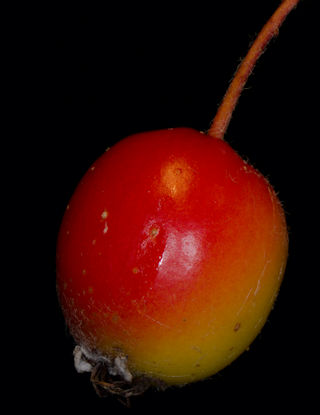|
At 1/4 to 2 inches in diameter, crab apples look like
miniature versions of regular apples. However, a crab apple has a sour, pithy
taste. Despite their unpleasant sharpness, crab apples generally aren't
dangerous. Crab apples might give you a sore stomach if you eat a few, but they
won't cause poisoning. Like regular apples, their seeds do contain toxins.
However, you would have to eat them in huge doses to experience any serious problems.
Crab apples usually aren't grown for their fruit. The little
crab apples are so sharp and bitter that most people just spit them right out
again. You can use some slightly mellower larger crab apple varieties for jam
making. Flowering crab apple trees are attractive in gardens. Like their close
cousin, the apple, crab apple trees often bloom in pretty white or purple
flowers. This makes them useful as an ornamental species.
Toxicity
Crab apples are essentially the same species as apple trees.
The seeds of both of these trees contain a form of cyanide called cyanogenic
glycosides. Cyanide is a toxic, potentially fatal poison. However, the average
American eats around 16.9 pounds of fresh apples every year and reports no
toxic effects. Despite the presence of cyanide in the seeds, most people don't
eat the core. Even when apple seeds are ingested, they usually pass through the
gut without being broken down. You would have to eat lots of crab apple seeds
and grind or chew them up for the cyanide to take effect.
Crab apples are popular as compact ornamental trees,
providing blossom in spring and colourful fruit in autumn. The fruits often
persist throughout winter. Numerous hybrid cultivars have been selected, of
which 'Evereste' and 'Red Sentinel' have gained The Royal Horticultural
Society's Award of Garden Merit.
Crab apple or wild apple is 2-3 inches in diameter and
spherical in shape. It is whitish-yellow in colour (unripe) and red (ripe). A
ripe crab apple has a hard crust and white pulp. The outer surface of this
fruit is rough and plushy. It is sour in taste. The tree of this fruit is quite
tall, and its trunk and branches are found to be covered with long and thick
spikes. Crab apple contains 64.2% water, 18% carbohydrates, 7.1% proteins, 5.0%
fibre, 3.7% fats and 1.9% mineral salts.
Its mineral and living content consists of Calcium,
Phosphorus, Iron, Karyotin, Thymine, Riboflavin, Niacin and Vitamin C. Its pulp
is rich in oxalic acid, citric acid and tannic acid. It provides 134 calories
per 100 grams.
|
|
The pulp of the unripen crab apple is effective in closing
open bleeding wounds. A ripen crab apple is a powerful digestive agent. It
gives relief from congestion. Furthermore it is quite beneficial for scurvy
patients. Eating unripen crab apple without seeds proves to be highly curative
against diarrhoea and piles (Haemorrhoids). This fully ripened fruit when mixed
with sugar and made into syrup helps in overcoming the intense thirst during
fever. A very special paste is made from the crab apple which is an effective
remedy for hiccups, throat diseases and breathing problems. This paste consists
of the following ingredients: Sea salt, Dried ginger, Black pepper, Honey.
WHAT SHOULD WE GO FOR?
Nature holds various solutions within it. It is upon a
person to fully discover, explore and make full use of these brilliant gifts.
All the remedies given are purely natural.
Before taking herbal remedies always see your doctor.
|

